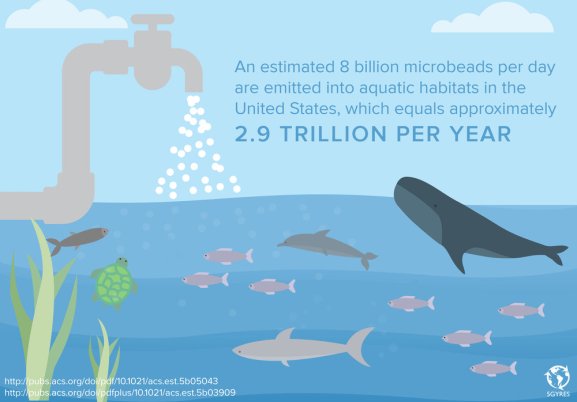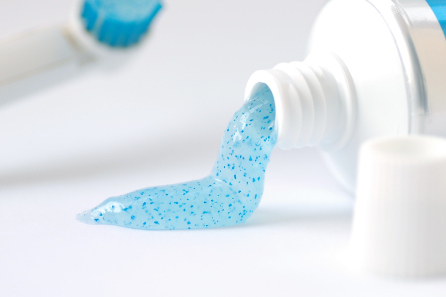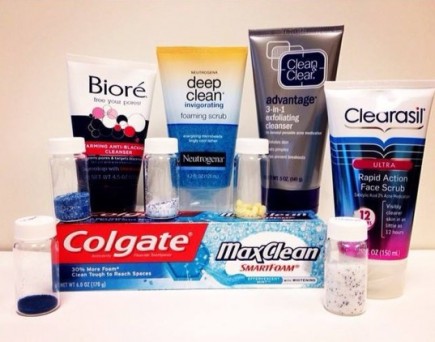
Microbeads are man-made solid plastic particles cosmetic companies put in their products for exfoliating power. But once you wash your face, these microbeads go down the drain straight into waterways and waste water treatment plants. They are so small – about a millimeter in diameter –that they are hard to detect except with a microscope. Commonly made of polyethylene, they are also made up of polypropylene.
A September 2015 study published in the journal Environmental Science & Technology estimated that 808 trillion plastic microbeads are washed down US household drains every day. Of those, eight trillion make it through water treatment plants. According to the UK parliament’s environmental audit committee, a single shower can result in 100,000 plastic particles being washed down the drain.
EPA findings of researchers at the Marine and Freshwater Research Centre at Galway Mayo Institute of Technology (GMIT) confirmed the “potential risks” to humans from drinking water or eating food that contain microbeads.
The Netherlands was the first country to ban cosmetic microbeads in 2014. In December of that year it was joined by Austria, Luxembourg, Belgium and Sweden in issuing a joint statement to EU environment ministers calling for an EU-wide ban on micro-plastics.
The United States enacted a ban in December 2015 which will prohibit production of cosmetics containing microbeads from July 2017
The import or manufacture of toiletries containing microbeads was banned on 1 January 2018 and sales were banned from 1 July 2018. Microbeads in natural health products and non-prescription drugs will also be banned in 2019.

Because microbeads are so small, wastewater treatment plant technology may not be capable of removing them from the wastes stream.
circleofblue.org: “The ornate steps to supply running water to virtually every household in the country represent diligent investments in reservoirs, pumps, pipes, and treatment plants that began in the 19th and early 20th centuries. Now, …many of those systems neglected for decades are in need of maintenance and repairs. Though they differ on the precise figures, most assessment reports by both government agencies and interest groups agree that the bill amounts to hundreds of billions of dollars over the next two decades.”
css.umich.edu reported that: “In 2012, U.S. clean water needs for building new and updating existing wastewater treatment plants, pipe repair and new pipes, and combined sewer overflow corrections were $102.0, $95.7, and $48.0 billion, respectively.
The American Water Works Association’s (AWWA’s) State of the Water Industry (SOTWI) report for 2015 lists renewal and replacement of water and wastewater infrastructure at the top.
A known problem with traditional reverse osmosis (RO) application of wastewater is that chlorine in the wastewater causes degradation of the RO membranes. This can only be solved by having a chlorine removal for the RO feed stream.
“To be specific but indelicate, tiny plastic particles and fibers have been found in the stool of eight people who provided samples as part of a pilot study.”
Philipp Schwabl, the physician-scientist who conducted the human stool experiment, says he hopes his findings will hasten research into the effects of microplastics on human health.
https://www.nationalgeographic.com/environment/2018/10/news-plastics-microplastics-human-feces/

Wells Scheeler, Treasure Coast Pure Waters, Sebastian FL. contributed to this article.
Mr. Scheeler is a 35 year authority on the safety of tap water.
His website has many articles about water quality and points us to the most effective method to ensure we are consuming the cleanest water possible.
Distillation mimics natures way of providing fresh clean water.
772.205.5013
http://www.myaquanui.com/tcpurewater